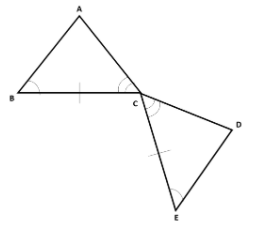

This diagram illustrates the geometric principle of angle-angle-side triangle congruence: given triangle ABC and triangle A'B'C', triangle ABC is congruent with triangle A'B'C' if and only if: angle CAB is congruent with angle C'A'B', and angle ABC is congruent with angle A'B'C', and BC is congruent with B'C'. So two distinct plane figures on a piece of paper are congruent if we can cut them out and then match them up completely.

This means that either object can be repositioned and reflected (but not resized) so as to coincide precisely with the other object. More formally, two sets of points are called congruent if, and only if, one can be transformed into the other by an isometry, i.e., a combination of rigid motions, namely a translation, a rotation, and a reflection. In geometry, two figures or objects are congruent if they have the same shape and size, or if one has the same shape and size as the mirror image of the other. The unchanged properties are called invariants. Congruence permits alteration of some properties, such as location and orientation, but leaves others unchanged, like distances and angles. The last triangle is neither congruent nor similar to any of the others.

The two triangles on the left are congruent, while the third is similar to them. Have you seen the geometric mean elsewhere? Let me know. Draw perpendiculars $PQ,\ $ $PR,\ $ and $PS\ $ from $P\ $ to $AB\ $ and the tangents to the circle at $A\ $ and $B.\ $ Then $PQ^.$ Let $AB\ $ be a chord in a circle and $P\ $ a point on the circle. Let their radii be $a\ $, $p,\ $ $b\ $ in the decreasing order, then $p\ $ is the mean proportional of $a\ $ and $b\ $. Inscribe the incircles into three similar and similarly obtained triangles. The process of inscribing a square continues for two more steps with the cut off triangles. In one of the simplest sangaku a square is inscribed into a right triangle. In the framework of the See-Saw Lemma, if a semicircle is inscribed between two perpendiculars to its diameter and a transversal tangent to the semicircle cut segments of lengths $a\ $ and $b\ $ from the two lines, then the radius of the semicircle is the geometric mean of $a\ $ and $b\ $. The geometric mean appeared as a tangent to a circle in John Wallis' very first geometric interpretation of complex numbers: The length of the common tangent of two circles of diameters $a\ $ and $b\ $ that are tangent externally is the geometric mean of the diameters: In fact the geometric mean makes quite frequent appearances in a variety of geometric situations. If we pair the big triangle with any of the smaller ones, we'll find that a leg of a right triangle is the mean proportional between its projection on the hypotenuse and the hypotenuse itself. The corollary to VI.8 is derived from the similarity of two small triangles. For example, in a right triangle with the altitude to the hypotenuse drawn we may observe three similar triangles: the given one, and the smaller ones cut off by the altitude.

However this is not the only appearance of the mean proportional in right triangle. The above construction of the mean proportional is based on a Corollary from Euclid VI.8: If in a right-angled triangle a perpendicular is drawn from the right angle to the base, then the straight line so drawn is a mean proportional between the segments of the base. The fourth proportional of the given numbers $a\ $, $b\ $, $c\ $ is number $x\ $ such that $ab = c/x.\ $ The third proportional of two numbers $a\ $ and $b\ $ is number $y\ $ such that $a/b = b/y.\ $ Also, this same construction is used by Euclid II.14 to construct a square of the same area as a given rectangle.) (In passing, the are two more terms in Euclid VI that relate to the proportions like the above. The length of the perpendicular from the circumference to the diameter is exactly the geometric mean of $a\ $ and $b\ $. It appears in a more algebraic setting as the mean proportional $p\ $ between two numbers $a\ $ and $b\ $:Įuclid VI.13 gives a geometric construction of the mean proportional:ĭraw a semicircle on a diameter of length $a + b\ $ and a perpendicular to the diameter where the two segments join. In all likelihood, this particular problem gave that number its commonly used name: the geometric mean. The geometric mean then answers this question: given a rectangle with sides $a\ $ and $b\ $, find the side of the square whose area equals that of the rectangle. While it is possible to (at least partially) adapt the definition to handle negative numbers, I do not believe this is ever done. The geometric mean of two positive numbers $a\ $ and $b\ $ is the (positive) number g whose square equals the product $ab\ $:


 0 kommentar(er)
0 kommentar(er)
